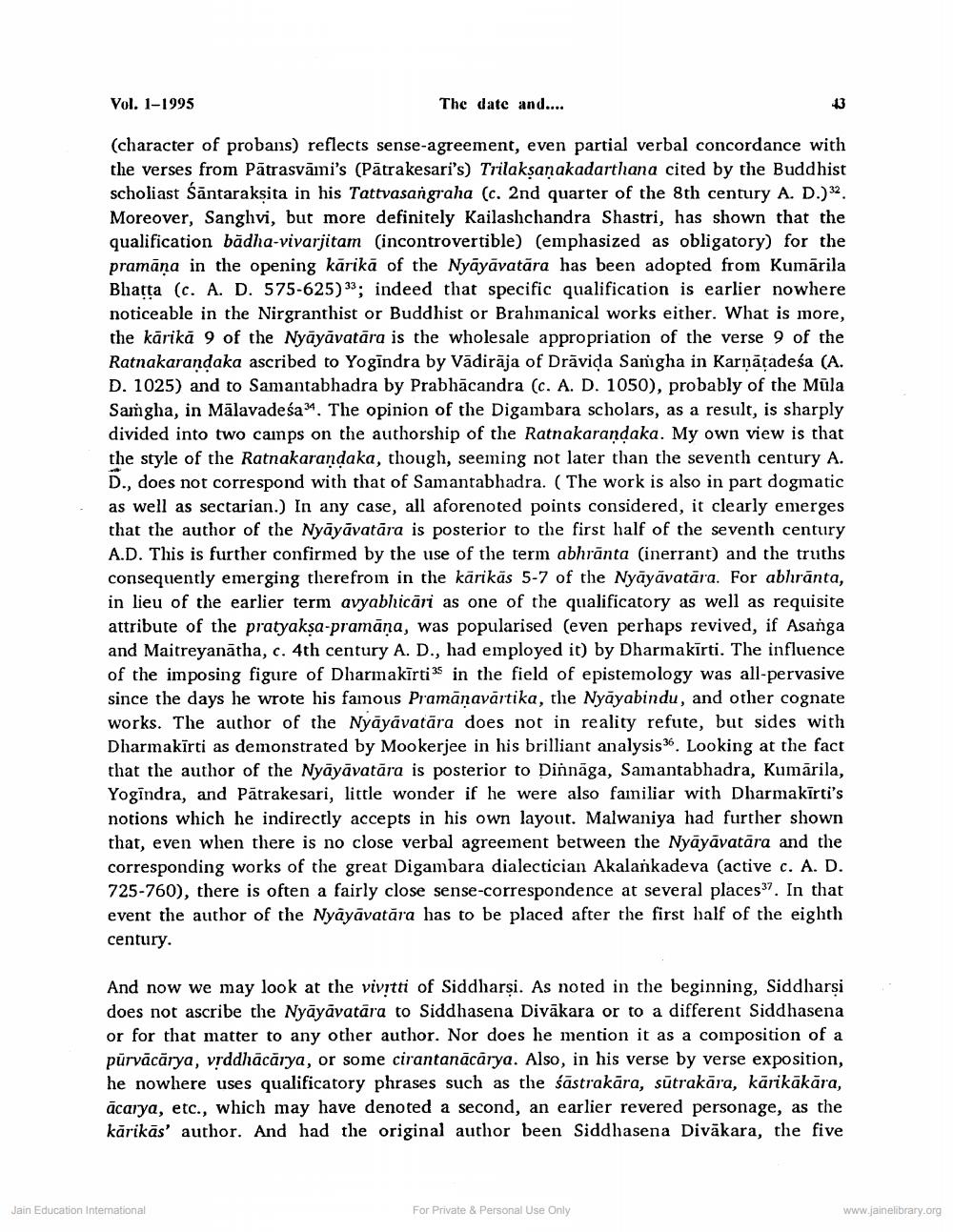________________
Vol. 1-1995
The date and....
(character of probans) reflects sense-agreement, even partial verbal concordance with the verses from Pātrasvāmi's (Pātrakesari's) Trilaksanakadarthana cited by the Buddhist scholiast śāntarakṣita in his Tattvasangraha (c. 2nd quarter of the 8th century A. D.) 32. Moreover, Sanghvi, but more definitely Kailashchandra Shastri, has shown that the qualification badha-vivarjitam (incontrovertible) (emphasized as obligatory) for the pramāņa in the opening kārikā of the Nyāyāvatāra has been adopted from Kumārila Bhatta (c. A. D. 575-625) 33; indeed that specific qualification is earlier nowhere noticeable in the Nirgranthist or Buddhist or Brahmanical works either. What is more, the kāriká 9 of the Nyāyāvatāra is the wholesale appropriation of the verse 9 of the Ratnakarandaka ascribed to Yogindra by Vădirāja of Drāvida Sangha in Karnātadeśa (A. D. 1025) and to Samantabhadra by Prabhācandra (c. A. D. 1050), probably of the Müla Samgha, in Mālavadeśa34. The opinion of the Digambara scholars, as a result, is sharply divided into two camps on the authorship of the Ratnakarandaka. My own view is that the style of the Ratnakarandaka, though, seeming not later than the seventh century A. D., does not correspond with that of Samantabhadra. ( The work is also in part dogmatic as well as sectarian.) In any case, all aforenoted points considered, it clearly emerges that the author of the Nyāyāvatāra is posterior to the first half of the seventh century A.D. This is further confirmed by the use of the term abhrānta (inerrant) and the truths consequently emerging therefrom in the karikās 5-7 of the Nyāyāvatāra. For abhrānta, in lieu of the earlier term avyabhicāri as one of the qualificatory as well as requisite attribute of the pratyaksa-pramāņa, was popularised (even perhaps revived, if Asanga and Maitreyanātha, c. 4th century A. D., had employed it) by Dharmakirti. The influence of the imposing figure of Dharmakīrti 35 in the field of epistemology was all-pervasive since the days he wrote his famous Pramāņavārtika, the Nyāyabindu, and other cognate works. The author of the Nyāyāvatāra does not in reality refute, but sides with Dharmakīrti as demonstrated by Mookerjee in his brilliant analysis 36. Looking at the fact that the author of the Nyāyāvatāra is posterior to Dinnaga, Samantabhadra, Kumārila, Yogindra, and Pātrakesari, little wonder if he were also familiar with Dharmakīrti's notions which he indirectly accepts in his own layout. Malwaniya had further shown that, even when there is no close verbal agreement between the Nyāyāvatāra and the corresponding works of the great Digambara dialectician Akalankadeva (active c. A. D. 725-760), there is often a fairly close sense-correspondence at several places. In that event the author of the Nyāyāvatāra has to be placed after the first half of the eighth century.
And now we may look at the vivitti of Siddharși. As noted in the beginning, Siddharsi does not ascribe the Nyāyāvatāra to Siddhasena Divākara or to a different Siddhasena or for that matter to any other author. Nor does he mention it as a composition of a pūrvācārya, vrddhācārya, or some cirantanācārya. Also, in his verse by verse exposition, he nowhere uses qualificatory phrases such as the śāstrakāra, sūtrakāra, kārikākāra, ācarya, etc., which may have denoted a second, an earlier revered personage, as the kārikās' author. And had the original author been Siddhasena Divākara, the five
Jain Education Intemational
For Private & Personal Use Only
www.jainelibrary.org




